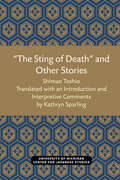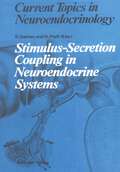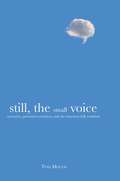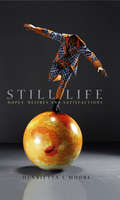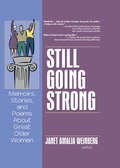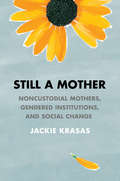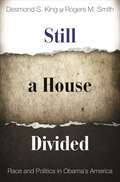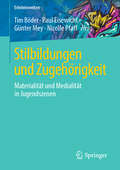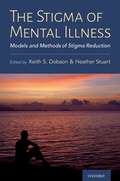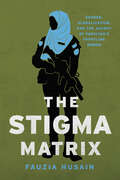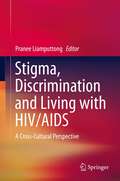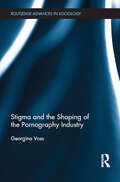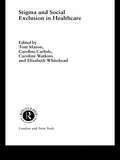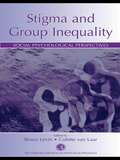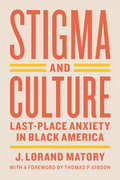- Table View
- List View
“The Sting of Death” and Other Stories (Michigan Papers in Japanese Studies #12)
by Toshio ShimaoUntil a recent “boom,” Shimao Toshio, writer of short fiction, critic, and essayist, was not widely known, even in Japan. He has never won the Akutagawa or the Naoki Prize, and none of his works had previously appeared in English translation. He is less well known than other writers (Yasuoka Shotaro, Kojima Nobuo, and Shono Junzo) with whom he has associated and whose works have been liberally translated into English. Yet, there are those who consider him to be one of the best contemporary writers in Japan. This volume by no means exhausts the scope of Shimao's fiction. There are no stories here, for instance, about childhood or student life, and none of his many travel stories. Some of his most famous stories-- "When we Never Left Port," for example--have not been included. But the stories presented here do offer a considerable variety of style, from the pristine storybook language of "The Farthest Edge of the Islands," to the young intellectual's jargon of "Everyday Life in a Dream," to the visionary, hysterical, occasionally ritualistic prose of the "sick wife" stories, to the sober, difficult, almost ponderous narration of "This Time That Summer." Shimao's approach to his material varies as well. "Everyday Life in a Dream" is the only representative here of a large number of stories usually called surrealistic by the critics, stories whose plots progress by the logic of dreams. The individual experience of real life are lived through a combination of conscious and unconscious perception. These stories are the least approachable and the least charming to the casual reader, but they serve, among other things, to highlight patterns in the more realistic fiction. "The Farthest Edge of the Islands" is a symbolic heightening of reality in another way, a romantic fairy tale beginning at the extremity of experience, at the farthest edge of the world. The other stories are presented as precise, close chronicles of reality by a participant in that reality whose attention never waivers and who never allows himself to avert his eyes from a world that he sees as his responsibility and in a sense his fault. All but the first story, "The Farthest Edge of the Islands," which is in third-person narration, are told in the first person by the character who plays Shimao's role in the life that inspired the fiction.
Stimulus-Secretion Coupling in Neuroendocrine Systems (Current Topics in Neuroendocrinology #9)
by Brian Pickering I. M. Cooke H. Duve D. K. Hartline G. I. Hatton W. J. Malaisse R. W. Newcomb L. J. Parry D. A. Poulain F. Strumwasser E. L. Stuenkel A.J.S. Summerlee D. T. Theodosis A. ThorpeThe role of electrical signalling in the control of endocrine secretions by the brain has been clear for many years. Recently, the influences of hormones on synthetic events in neuroendocrine cells have raised new questions concerning the peptides released from such neurons. This volume concentrates on the relation between these two fields and asks how electrical action potentials facilitate secretion of substances from nerve cells which control endocrine events. While stimulus-secretion coupling has been studied extensively in other physiological contexts, this is the first treatment of the phenomenon in an exclusively neuroendocrine setting.
Still, the Small Voice: Narrative, Personal Revelation, and the Mormon Folk Tradition
by Tom MouldMemorates—personal experience narratives of encounters with the supernatural—that recount individuals’ personal revelations, primarily through the Holy Ghost, are a pervasive aspect of the communal religious experience of Mormons, members of the Church of Jesus Christ of Latter-day Saints. In accordance with current emphases in folklore studies on narrative and belief, Tom Mould uses ethnographic research and an emic approach that honors the belief systems under study to analyze how people within Mormon communities frame and interpret their experiences with the divine through the narratives they share. In doing so, he provides a significant new ethnographic interpretation of Mormon culture and belief and also applies his findings directly to broader scholarly folklore discourse on performance, genre, personal experience narrative, belief, and oral versus written traditions.
Still No Idea (Oberon Modern Plays)
by Lisa Hammond Rachael Spence Lee SimpsonBest mates Lisa and Rachael are making a new show almost a decade after they created their first piece together.Back then they had no idea where to start so they went onto the streets and asked the public. What story should they tell? What characters should they play? When they saw Lisa in a wheelchair and Rachael not, what the public said was funny, jaw-dropping and ultimately heartbreaking. They made a show about it. It was called No Idea.Now people say the world has changed and things are looking up. There are more disabled people in the mainstream media, Lisa landed a big part on TV and disabled mates are getting regular auditions - happy days. So what kind of exciting stories are the TV professionals dreaming up for them?Still No Idea is the whole story (so far): the British public, the professional writers, the TV execs. Part verbatim theatre, part improv, part comedy sketch show, this is a raucous and mischievous exposé of good intentions gone bad and how sometimes no matter how hard we try, we still have absolutely no idea.
Still Life: Hopes, Desires and Satisfactions
by Henrietta L. MooreHow adequate are our theories of globalisation for analysing the worlds we share with others? In this provocative new book, Henrietta Moore asks us to step back and re-examine in a fresh way the interconnections normally labeled 'globalisation'. Rather than beginning with abstract processes and flows, Moore starts by analyzing the hopes, desires and satisfactions of individuals in their day-to-day lives. Drawing on a wide range of examples, from African initiation rituals to Japanese anime, from sex in virtual worlds to Schubert songs, Moore develops a theory of the ethical imagination, exploring how ideas about the human subject, and its capacities for self-making and social transformation, form a basis for reconceptualizing the role and significance of culture in a global age. She shows how the ideas of social analysts and ordinary people intertwine and diverge, and argues for an ethics of engagement based on an understanding of the human need to engage with cultural problems and seek social change. This innovative and challenging book is essential reading for anyone interested in the key debates about culture and globalization in the contemporary world.
Still Life: Hopes, Desires and Satisfactions
by Henrietta L. MooreHow adequate are our theories of globalisation for analysing the worlds we share with others? In this provocative new book, Henrietta Moore asks us to step back and re-examine in a fresh way the interconnections normally labeled 'globalisation'. Rather than beginning with abstract processes and flows, Moore starts by analyzing the hopes, desires and satisfactions of individuals in their day-to-day lives. Drawing on a wide range of examples, from African initiation rituals to Japanese anime, from sex in virtual worlds to Schubert songs, Moore develops a theory of the ethical imagination, exploring how ideas about the human subject, and its capacities for self-making and social transformation, form a basis for reconceptualizing the role and significance of culture in a global age. She shows how the ideas of social analysts and ordinary people intertwine and diverge, and argues for an ethics of engagement based on an understanding of the human need to engage with cultural problems and seek social change. This innovative and challenging book is essential reading for anyone interested in the key debates about culture and globalization in the contemporary world.
Still Going Strong: Memoirs, Stories, and Poems About Great Older Women
by Janet Amalia WeinbergIt's terrible to get old? Life is all downhill after fifty? That's what our youth-centered culture may think but don't be duped. Selected as a finalist for 2006 Independent Publisher Book Awards, this book can change how you think about aging, even make you feel good about getting old! “. . . a liberating change is happening, a change as momentous as the liberation movements of the 1960s and 70s. It brings respect for older people, appreciation for maturity, and the promise of a more balanced culture.”—from the Introduction by Margaret Karmazin and Janet Amalia Weinberg. Discover a new, positive way of looking at aging with Still Going Strong: Memoirs, Stories, and Poems About Great Older Women. This exuberant, inspiring anthology celebrates the vitality of older women and shows them having adventures, facing loss, enjoying romance, and feeling more capable and confident than ever. The 42 authors included in the collection know that life after middle age is not the diminished state dreaded by our youth-centered culture, but rather, a time of growth and fulfillment, enriched by the wisdom of experience and perspective. Get a taste of the passion, wit, and wisdom of some of these women: From “Why Vermont” by Elayne Clift:“It was great not to be driven by achievement. I was learning the art of laid-back living. Spending a day writing, or reading, was heavenly and I was reminded of my freedom whenever a friend said, ‘I'd give anything to be doing that!’” From “Gray Matters” by Marsha Dubrow:“. . . finally [I] have decided to enjoy being a gray. It links me with a powerful sisterhood, complimenting each other on our gray badge of courage. A woman with dreadlocks resembling pillars of salt approached me on the street and said, ‘You go, girlfriend. We're gray and we're proud—and gorgeous.’ We smacked high fives.” From “Katherine Banning: Wife, Mother, Bank Robber” by Melissa Lugo:“Crazy, you say? Well, wait till you hit 90 and realize you still want to live, that even though you're way past menopause you want another child, and that even though your breasts make tracks in the mud, you still want a lover, and that even though your hands shake, there are still things that you didn't get to do (like going to the Olympics and bringing home the gold) things you want to do, that you will do. Then, see what you're capable of. And you'll be perfectly sane. Senility, temporary insanity, it's all bull. Old folks know exactly what they're doing. One of the good parts about being an old fart is that you have a license to be loony tunes, to live the wild way you didn't have the balls for before. At 90, you see, your dignity's gone the way of dirty diapers, and your life is heading the same way fast. You have nothing to lose except the moment.” From “A Different Woman” by Joan Kip:“My relationship with Seth is, I tell him, my great experiment. He calls me on every one of my tightly-held protections, and his pleasure in meeting my body is matched by my own freedom to respond. Ours is a relationship with no hidden agenda, no commitments. Our occasional evenings of uncomplicated delight are the intertwining of two desires who touch down and embrace one another, knowing they will meet again, sometime, somewhere. And while sex is not absent from our meetings, it is, rather, my compelling ache to be touched and held and to touch and hold that pulls me back each time to Seth. Like the newly-born whose being depends upon the enfolding presence of a parent, those of us who are now so old, glow more warmly when we, too, may share our tenderness.” Still Going Strong counters demeaning stereotypes of “little old ladies” by offering positive, empowering views of women over fifty. It is a hopeful voice that speaks to any woman facing her own future.
Still Going Strong: Memoirs, Stories, and Poems About Great Older Women
by Janet Amalia WeinbergIt's terrible to get old? Life is all downhill after fifty? That's what our youth-centered culture may think but don't be duped. Selected as a finalist for 2006 Independent Publisher Book Awards, this book can change how you think about aging, even make you feel good about getting old! “. . . a liberating change is happening, a change as momentous as the liberation movements of the 1960s and 70s. It brings respect for older people, appreciation for maturity, and the promise of a more balanced culture.”—from the Introduction by Margaret Karmazin and Janet Amalia Weinberg. Discover a new, positive way of looking at aging with Still Going Strong: Memoirs, Stories, and Poems About Great Older Women. This exuberant, inspiring anthology celebrates the vitality of older women and shows them having adventures, facing loss, enjoying romance, and feeling more capable and confident than ever. The 42 authors included in the collection know that life after middle age is not the diminished state dreaded by our youth-centered culture, but rather, a time of growth and fulfillment, enriched by the wisdom of experience and perspective. Get a taste of the passion, wit, and wisdom of some of these women: From “Why Vermont” by Elayne Clift:“It was great not to be driven by achievement. I was learning the art of laid-back living. Spending a day writing, or reading, was heavenly and I was reminded of my freedom whenever a friend said, ‘I'd give anything to be doing that!’” From “Gray Matters” by Marsha Dubrow:“. . . finally [I] have decided to enjoy being a gray. It links me with a powerful sisterhood, complimenting each other on our gray badge of courage. A woman with dreadlocks resembling pillars of salt approached me on the street and said, ‘You go, girlfriend. We're gray and we're proud—and gorgeous.’ We smacked high fives.” From “Katherine Banning: Wife, Mother, Bank Robber” by Melissa Lugo:“Crazy, you say? Well, wait till you hit 90 and realize you still want to live, that even though you're way past menopause you want another child, and that even though your breasts make tracks in the mud, you still want a lover, and that even though your hands shake, there are still things that you didn't get to do (like going to the Olympics and bringing home the gold) things you want to do, that you will do. Then, see what you're capable of. And you'll be perfectly sane. Senility, temporary insanity, it's all bull. Old folks know exactly what they're doing. One of the good parts about being an old fart is that you have a license to be loony tunes, to live the wild way you didn't have the balls for before. At 90, you see, your dignity's gone the way of dirty diapers, and your life is heading the same way fast. You have nothing to lose except the moment.” From “A Different Woman” by Joan Kip:“My relationship with Seth is, I tell him, my great experiment. He calls me on every one of my tightly-held protections, and his pleasure in meeting my body is matched by my own freedom to respond. Ours is a relationship with no hidden agenda, no commitments. Our occasional evenings of uncomplicated delight are the intertwining of two desires who touch down and embrace one another, knowing they will meet again, sometime, somewhere. And while sex is not absent from our meetings, it is, rather, my compelling ache to be touched and held and to touch and hold that pulls me back each time to Seth. Like the newly-born whose being depends upon the enfolding presence of a parent, those of us who are now so old, glow more warmly when we, too, may share our tenderness.” Still Going Strong counters demeaning stereotypes of “little old ladies” by offering positive, empowering views of women over fifty. It is a hopeful voice that speaks to any woman facing her own future.
Still a Mother: Noncustodial Mothers, Gendered Institutions, and Social Change
by Jackie KrasasJackie Krasas traces the trajectories of mothers who have lost or ceded custody to an ex-partner. She argues that these noncustodial mothers' experiences should be understood within a greater web of gendered social institutions such as employment, education, health care, and legal systems that shapes the meanings of contemporary motherhood in the United States. If motherhood means "being there," then noncustodial mothers, through their absence, are seen as nonmothers. They are anti-mothers to be reviled. At the very least, these mothers serve as cautionary tales.Still a Mother questions the existence of an objective method for determining custody of children and challenges the "best-interests standard" through a feminist, reproductive justice lens. The stories of noncustodial mothers that Krasas relates shed light on marriage and divorce, caregiving, gender violence, and family court. Unfortunately, much of the contemporary discussion of child custody determination is dominated either by gender-neutral discussions, or, at the opposite end of the spectrum, by the idea that fathers are severely disadvantaged in custody disputes. As a result, the idea that mothers always receive custody has taken on the status of common sense. If this was true, as Krasas affirms, there would be no book to write.
Still a House Divided: Race and Politics in Obama’s America
by Desmond S. King Rogers M. SmithWhy have American policies failed to reduce the racial inequalities still pervasive throughout the nation? Has President Barack Obama defined new political approaches to race that might spur unity and progress? Still a House Divided examines the enduring divisions of American racial politics and how these conflicts have been shaped by distinct political alliances and their competing race policies. Combining deep historical knowledge with a detailed exploration of such issues as housing, employment, criminal justice, multiracial census categories, immigration, voting in majority-minority districts, and school vouchers, Desmond King and Rogers Smith assess the significance of President Obama's election to the White House and the prospects for achieving constructive racial policies for America's future. Offering a fresh perspective on the networks of governing institutions, political groups, and political actors that influence the structure of American racial politics, King and Smith identify three distinct periods of opposing racial policy coalitions in American history. The authors investigate how today's alliances pit color-blind and race-conscious approaches against one another, contributing to political polarization and distorted policymaking. Contending that President Obama has so far inadequately confronted partisan divisions over race, the authors call for all sides to recognize the need for a balance of policy measures if America is to ever cease being a nation divided. Presenting a powerful account of American political alliances and their contending racial agendas, Still a House Divided sheds light on a policy path vital to the country's future.
Still a House Divided: Race and Politics in Obama’s America
by Desmond S. King Rogers M. SmithWhy have American policies failed to reduce the racial inequalities still pervasive throughout the nation? Has President Barack Obama defined new political approaches to race that might spur unity and progress? Still a House Divided examines the enduring divisions of American racial politics and how these conflicts have been shaped by distinct political alliances and their competing race policies. Combining deep historical knowledge with a detailed exploration of such issues as housing, employment, criminal justice, multiracial census categories, immigration, voting in majority-minority districts, and school vouchers, Desmond King and Rogers Smith assess the significance of President Obama's election to the White House and the prospects for achieving constructive racial policies for America's future. Offering a fresh perspective on the networks of governing institutions, political groups, and political actors that influence the structure of American racial politics, King and Smith identify three distinct periods of opposing racial policy coalitions in American history. The authors investigate how today's alliances pit color-blind and race-conscious approaches against one another, contributing to political polarization and distorted policymaking. Contending that President Obama has so far inadequately confronted partisan divisions over race, the authors call for all sides to recognize the need for a balance of policy measures if America is to ever cease being a nation divided. Presenting a powerful account of American political alliances and their contending racial agendas, Still a House Divided sheds light on a policy path vital to the country's future.
Stilbildungen und Zugehörigkeit: Materialität und Medialität in Jugendszenen (Erlebniswelten)
by Tim Böder Paul Eisewicht Günter Mey Nicolle PfaffSzenezugehörigkeiten können als in stilspezifischen Praktiken sozial hervorgebrachte und sinnstiftende Gemeinsamkeiten des Handelns verstanden werden. Sie werden in den jeweiligen Stilbildungen über materielle Artefakte und deren Gebrauch, den Körper sowie mediale Ausdrucksformen angezeigt, inszeniert, stabilisiert und verbreitet. Wenngleich die Bedeutung von Artefakten, Körpern und Medien für Stilisierungsprozesse innerhalb der Jugendkultur- und Szeneforschung kontinuierlich hervorgehoben wird, so rückt die systematische Analyse der materiellen und medialen Dimensionen jugendkulturellen Handelns über die Deskription jeweiliger Stile hinaus nur selten in den Blickpunkt. Von dieser Beobachtung ausgehend soll mit diesem Band der Frage nachgegangen werden, mit welchen theoretischen und methodischen Perspektiven eine interdisziplinäre Jugendkultur- und Szeneforschung die materiellen und medialen Ausdrucksformen von Stilen adäquat verstehen kann. Der Band versammelt Beiträge, die sich der Bedeutung von Materialität und Medialität in Szenen aus historischer, sozial- und kulturwissenschaftlicher sowie psychologischer Perspektive widmen.Der InhaltJugendkulturtheoretische Perspektiven auf Medialität und Materialität • Stilbildungen über Medien • Stilbildungen über Artefakte • Stilbildungen über Körper Die HerausgeberTim Böder ist wissenschaftlicher Mitarbeiter der AG Jugend- und Schulforschung an der Universität Duisburg-Essen.Dr. Paul Eisewicht ist wissenschaftlicher Mitarbeiter am Institut für Soziologie an der Technischen Universität Dortmund.Prof. Dr. Günter Mey lehrt Entwicklungspsychologie und qualitative Forschung an der Hochschule Magdeburg-Stendal.Prof. Dr. Nicolle Pfaff ist Hochschullehrerin an der Fakultät für Bildungswissenschaften an der Universität Duisburg-Essen.
The Stigma of Mental Illness: Models and Methods of Stigma Reduction
by Keith Dobson Heather StuartStigma is one of the major barriers to care for people with mental health and related disorders. Stigma includes negative beliefs about and hostile perceptions towards others, shame and self-stigma, discriminatory practices in hiring, promotion and recognition of people who suffer from mental health challenges, and structural and organizational policies and processes that result in inequalities for people who have mental health challenges. Stigma has been recognized as a significant factor in the well-being of people with mental health and related problems and can be more debilitating than the direct effects of mental health problems themselves. The Mental Health Commission of Canada (MHCC) was established to conduct policy reviews and to promote initiatives related to mental health. The Opening Minds program of the MHCC is the largest systematic effort in Canadian history to reduce stigma related to mental illnesses. The program has adopted the systematic development, evaluation and deployment of targeted programs based on theories of change, best practices and available research evidence as a model for stigma reduction. The Stigma of Mental Illness is an important vehicle to communicate conceptual issues in the field of stigma reduction, to document the work done to date within the MHCC Opening Minds program, and to offer practical strategies to broaden the scope and utility of the work for different contexts, cultures, and countries. This volume will be a global interest, given the growing importance of stigma reduction related to mental disorders and related problems.
The Stigma of Mental Illness: Models and Methods of Stigma Reduction
by Keith Dobson Heather StuartStigma is one of the major barriers to care for people with mental health and related disorders. Stigma includes negative beliefs about and hostile perceptions towards others, shame and self-stigma, discriminatory practices in hiring, promotion and recognition of people who suffer from mental health challenges, and structural and organizational policies and processes that result in inequalities for people who have mental health challenges. Stigma has been recognized as a significant factor in the well-being of people with mental health and related problems and can be more debilitating than the direct effects of mental health problems themselves. The Mental Health Commission of Canada (MHCC) was established to conduct policy reviews and to promote initiatives related to mental health. The Opening Minds program of the MHCC is the largest systematic effort in Canadian history to reduce stigma related to mental illnesses. The program has adopted the systematic development, evaluation and deployment of targeted programs based on theories of change, best practices and available research evidence as a model for stigma reduction. The Stigma of Mental Illness is an important vehicle to communicate conceptual issues in the field of stigma reduction, to document the work done to date within the MHCC Opening Minds program, and to offer practical strategies to broaden the scope and utility of the work for different contexts, cultures, and countries. This volume will be a global interest, given the growing importance of stigma reduction related to mental disorders and related problems.
The Stigma Matrix: Gender, Globalization, and the Agency of Pakistan's Frontline Women (Globalization in Everyday Life)
by Fauzia HusainAs developing states adopt neoliberal policies, more and more working-class women find themselves pulled into the public sphere. They are pressed into wage work by a privatizing and unstable job market. Likewise, they are pulled into public roles by gender mainstreaming policies that developing states must sign on to in order to receive transnational aid. Their inclusion into the political economy is very beneficial for society, but is it also beneficial for women? In The Stigma Matrix Fauzia Husain draws on the experiences of policewomen, lady health workers, and airline attendants, all frontline workers who help the Pakistani state, and its global allies, address, surveil, and discipline veiled women citizens. These women, she finds, confront a stigma matrix: a complex of local and global, historic, and contemporary factors that work together to complicate women's integration into public life. The experiences of the three groups Husain examines reveal that inclusion requires more than quotas or special seats. This book advances critical feminist and sociological frameworks on stigma and agency showing that both concepts are made up of multiple layers of meaning, and are entangled with elite projects of hegemony.
The Stigma Matrix: Gender, Globalization, and the Agency of Pakistan's Frontline Women (Globalization in Everyday Life)
by Fauzia HusainAs developing states adopt neoliberal policies, more and more working-class women find themselves pulled into the public sphere. They are pressed into wage work by a privatizing and unstable job market. Likewise, they are pulled into public roles by gender mainstreaming policies that developing states must sign on to in order to receive transnational aid. Their inclusion into the political economy is very beneficial for society, but is it also beneficial for women? In The Stigma Matrix Fauzia Husain draws on the experiences of policewomen, lady health workers, and airline attendants, all frontline workers who help the Pakistani state, and its global allies, address, surveil, and discipline veiled women citizens. These women, she finds, confront a stigma matrix: a complex of local and global, historic, and contemporary factors that work together to complicate women's integration into public life. The experiences of the three groups Husain examines reveal that inclusion requires more than quotas or special seats. This book advances critical feminist and sociological frameworks on stigma and agency showing that both concepts are made up of multiple layers of meaning, and are entangled with elite projects of hegemony.
Stigma, Discrimination and Living with HIV/AIDS: A Cross-Cultural Perspective
by Pranee LiamputtongUp until now, many articles have been written to portray stigma and discrimination which occur with people living with HIV/AIDS (PLWHA) in many parts of the world. But this is the first book which attempts to put together results from empirical research relating to stigma, discrimination and living with HIV/AIDS. The focus of this book is on issues relevant to stigma and discrimination which have occurred to individuals and groups in different parts of the globe, as well as how these individuals and groups attempt to deal with HIV/AIDS. The book comprises chapters written by researchers who carry out their projects in different parts of the world and each chapter contains empirical information based on real life situations. This can be used as an evidence for health care providers to implement socially and culturally appropriate services to assist individuals and groups who are living with HIV/AIDS in many societies. The book is of interest to health care providers who have their interests in working with individuals and groups who are living with HIV/AIDS from a cross-cultural perspective. It will be useful for students and lecturers in courses such as anthropology, sociology, social work, nursing, public health and medicine. In particular, it will assist health workers in community health centres and hospitals in understanding issues related to HIV/AIDS and hence provide culturally sensitive health care to people living with HIV/AIDS from different social and cultural backgrounds. The book is useful for anyone who is interested in HIV/AIDS-related stigma and discrimination in diverse social and cultural settings.
Stigma and the Shaping of the Pornography Industry (Routledge Advances in Sociology)
by Georgina VossThe idea of ‘pornography’ is often employed to invoke titillation, anger, and disgust. Stigma and the Shaping of the Pornography Industry explores the effects that this stigmatized identity has on the pornography industry itself. From the video era to the emergence of the internet, to trade shows, white-collar workers, technological innovation, and industry-wide characteristics, this book looks beyond content production to explore how stigma has shaped the structures, practices, norms, and boundaries of the wider sector. By drawing on concepts such as dirty work, core-stigmatized industries, and outlaw innovation, this book offers rich insights into the ways in which stigma is socially constructed and managed, and the deep structural effects that it has on the industry.
Stigma and the Shaping of the Pornography Industry (Routledge Advances in Sociology)
by Georgina VossThe idea of ‘pornography’ is often employed to invoke titillation, anger, and disgust. Stigma and the Shaping of the Pornography Industry explores the effects that this stigmatized identity has on the pornography industry itself. From the video era to the emergence of the internet, to trade shows, white-collar workers, technological innovation, and industry-wide characteristics, this book looks beyond content production to explore how stigma has shaped the structures, practices, norms, and boundaries of the wider sector. By drawing on concepts such as dirty work, core-stigmatized industries, and outlaw innovation, this book offers rich insights into the ways in which stigma is socially constructed and managed, and the deep structural effects that it has on the industry.
Stigma and Social Exclusion in Healthcare
by Caroline Carlisle Tom Mason Caroline Watkins Elizabeth WhiteheadWhilst those in healthcare might like to think that they work to reduce stigma and social exclusion of others, this book reveals many strategies by which healthcare professionals contribute to increasing these conditions. Written by practitioners, some of whom have themselves been stigmatised, the book exposes the hidden processes of prejudice and the dogma of ideology that permeate contemporary healthcare. Engaging with the realities of stigma through a grassroots approach, topics covered include:* hearing* sight* sexuality* HIV and AIDS* drug use* teenage pregnancy* breastfeeding* old age.Stigma and Social Exclusion in Healthcare provides practical solutions to problems, recommendations for training and a blueprint for the future. It will prove a valuable reference for all those wanting to deal with the issues of stigmatisation.
Stigma and Social Exclusion in Healthcare
by Tom Mason Caroline Carlisle Caroline Watkins Elizabeth WhiteheadWhilst those in healthcare might like to think that they work to reduce stigma and social exclusion of others, this book reveals many strategies by which healthcare professionals contribute to increasing these conditions. Written by practitioners, some of whom have themselves been stigmatised, the book exposes the hidden processes of prejudice and the dogma of ideology that permeate contemporary healthcare. Engaging with the realities of stigma through a grassroots approach, topics covered include:* hearing* sight* sexuality* HIV and AIDS* drug use* teenage pregnancy* breastfeeding* old age.Stigma and Social Exclusion in Healthcare provides practical solutions to problems, recommendations for training and a blueprint for the future. It will prove a valuable reference for all those wanting to deal with the issues of stigmatisation.
Stigma and Group Inequality: Social Psychological Perspectives (Claremont Symposium on Applied Social Psychology Series)
by Shana Levin Colette Van LaarThis book provides a snapshot of the latest theoretical and empirical work on social psychological approaches to stigma and group inequality. It focuses on the perspective of the stigmatized groups and discusses the effects of the stigma on the individual, the interacting partners, the groups to which they belong, and the relations between the groups.Broken into three major sections, Stigma and Group Inequality:*discusses the tradeoffs that stigmatized individuals must contend with as they weigh the benefits derived from a particular response to stigma against the costs associated with it;*explores the ways in which environments can threaten one's intellectual performance, sense of belonging, and self concept; and*argues that the experience of possessing a stigmatized identity is shaped by social interactions with others in the stigmatized group as well as members of other groups.Stigma and Group Inequality is a valuable resource for students and scholars in the fields of psychology, sociology, social work, anthropology, communication, public policy, and political science, particularly for courses on stigma, prejudice, and intergroup relations. The book is also accessible to teachers, administrators, community leaders, and concerned citizens who are trying to understand and improve the plight of stigmatized individuals in school, at work, at home, in the community, and in society at large.
Stigma and Group Inequality: Social Psychological Perspectives (Claremont Symposium on Applied Social Psychology Series)
by Shana Levin Colette Van LaarThis book provides a snapshot of the latest theoretical and empirical work on social psychological approaches to stigma and group inequality. It focuses on the perspective of the stigmatized groups and discusses the effects of the stigma on the individual, the interacting partners, the groups to which they belong, and the relations between the groups.Broken into three major sections, Stigma and Group Inequality:*discusses the tradeoffs that stigmatized individuals must contend with as they weigh the benefits derived from a particular response to stigma against the costs associated with it;*explores the ways in which environments can threaten one's intellectual performance, sense of belonging, and self concept; and*argues that the experience of possessing a stigmatized identity is shaped by social interactions with others in the stigmatized group as well as members of other groups.Stigma and Group Inequality is a valuable resource for students and scholars in the fields of psychology, sociology, social work, anthropology, communication, public policy, and political science, particularly for courses on stigma, prejudice, and intergroup relations. The book is also accessible to teachers, administrators, community leaders, and concerned citizens who are trying to understand and improve the plight of stigmatized individuals in school, at work, at home, in the community, and in society at large.
Stigma and Culture: Last-Place Anxiety in Black America (Lewis Henry Morgan Lecture Series)
by J. Lorand MatoryIn Stigma and Culture, J. Lorand Matory provocatively shows how ethnic identification in the United States—and around the globe—is a competitive and hierarchical process in which populations, especially of historically stigmatized races, seek status and income by dishonoring other stigmatized populations. And there is no better place to see this than among the African American elite in academia, where he explores the emergent ethnic identities of African and Caribbean immigrants and transmigrants, Gullah/Geechees, Louisiana Creoles, and even Native Americans of partly African ancestry. Matory describes the competitive process that hierarchically structures their self-definition as ethnic groups and the similar process by which middle-class African Americans seek distinction from their impoverished compatriots. Drawing on research at universities such as Howard, Harvard, and Duke and among their alumni networks, he details how university life—while facilitating individual upward mobility, touting human equality, and regaling cultural diversity—also perpetuates the cultural standards that historically justified the dominance of some groups over others. Combining his ethnographic findings with classic theoretical insights from Frantz Fanon, Fredrik Barth, Erving Goffman, Pierre Bourdieu and others—alongside stories from his own life in academia—Matory sketches the university as an institution that, particularly through the anthropological vocabulary of culture, encourages the stigmatized to stratify their own.
Stigma and Culture: Last-Place Anxiety in Black America (Lewis Henry Morgan Lecture Series)
by J. Lorand MatoryIn Stigma and Culture, J. Lorand Matory provocatively shows how ethnic identification in the United States—and around the globe—is a competitive and hierarchical process in which populations, especially of historically stigmatized races, seek status and income by dishonoring other stigmatized populations. And there is no better place to see this than among the African American elite in academia, where he explores the emergent ethnic identities of African and Caribbean immigrants and transmigrants, Gullah/Geechees, Louisiana Creoles, and even Native Americans of partly African ancestry. Matory describes the competitive process that hierarchically structures their self-definition as ethnic groups and the similar process by which middle-class African Americans seek distinction from their impoverished compatriots. Drawing on research at universities such as Howard, Harvard, and Duke and among their alumni networks, he details how university life—while facilitating individual upward mobility, touting human equality, and regaling cultural diversity—also perpetuates the cultural standards that historically justified the dominance of some groups over others. Combining his ethnographic findings with classic theoretical insights from Frantz Fanon, Fredrik Barth, Erving Goffman, Pierre Bourdieu and others—alongside stories from his own life in academia—Matory sketches the university as an institution that, particularly through the anthropological vocabulary of culture, encourages the stigmatized to stratify their own.
